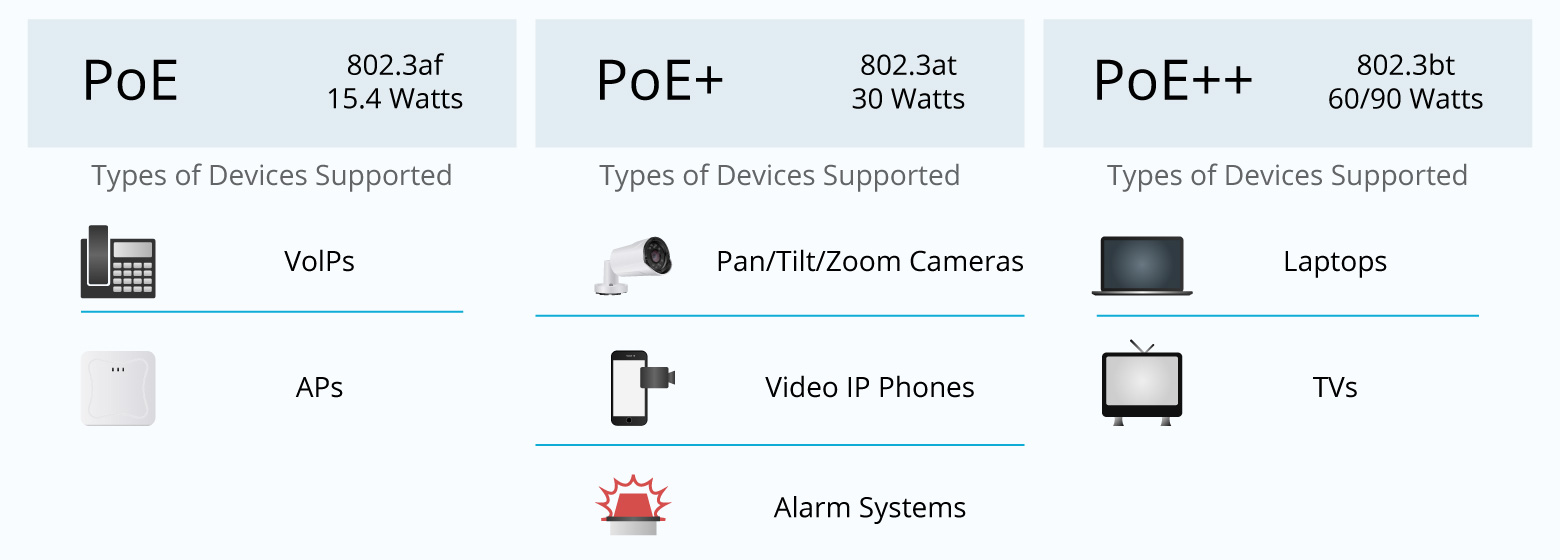
































Type 4 offers a maximum power output of 100W per PoE port (with a minimum of 71W on each PD port). This level of power delivery is ideal for devices like laptops and TVs.
Nom et prénom | IEEE Standard | PD Min. Power Per Le Port | PSE Max. Power Per Port | Energized Pairs | Appareils pris en charge |
PoE | IEEE 802.3af | 12.95W | 15.4W | 2-pair | Static surveillance cameras, VolP phones, wireless access points |
PoE+ | IEEE 802.3at | 25W | 30W | 2-pair | PTZ cameras, video IP phones, alarm systems |
PoE++ | IEEE 802.3bt | 51W | 60W | 4-pair | Video conferencing equipment, multi-radio wireless access points |
4PPoE | IEEE 802.3bt | 71W | 90 l | 4-pair | Laptops, flat screens |
As mentioned above, IEEE 802.3af delivers a maximum of 15.4W per port, while PoE+ supports up to 30W. The challenge arises when planning to connect multiple devices to a single PoE/PoE+ switch. It's essential to ensure that the total power requirements of these devices do not exceed the switch's maximum power wattage.
Par exemple, let's consider the S3410-48TS-P, a managed PoE+ switch with 48 RJ45 ports and 4 SFP ports. Compliant with IEEE 802.3af/at standards, this switch has a total power budget of 740l l. This ample budget means it can concurrently power devices compliant with PoE standards across all 48 ports if each requires 15.4W (15.4W x 48 = 739.2W, which is just below 740W). Additionally, it can support up to 24 devices compliant with the PoE+ standard (30W x 24 = 720W), all while staying within its power budget.

There's no need to worry about power management with modern network switches like the S3410-48TS-P. They are equipped with intelligent technology to automatically detect whether a connected device is compatible with PoE or PoE+. If a PoE-enabled device requires as little as 5W, the switch accurately delivers it. Should the device demand more power, up to 20W or beyond within its PoE+ capability, the switch will adjust accordingly. However, for devices not needing PoE, the switch simply functions to pass data, ensuring versatility in network configurations and device support.
The power needs of your devices depend on what you're connecting. Most devices, such as security cameras, IP phonesand standard wireless APs, require no more than 30 watts.
However, some devices, like 802.11ac wireless APs with multiple USB ports and radios, need over 30 watts for peak performance. For these cases, PoE++ or PoH switches are the solution. Keep in mind that some devices can adapt to lower power availability by using fewer radios or disabling features.
In the context of adhering to PoE standards and efficiently managing wattage requirements, PoE+ switches stand out as a prime example of technological advancement aimed at optimizing power distribution in network infrastructures. These switches are designed to seamlessly integrate with devices adhering to various PoE standards, ensuring that each device receives the precise amount of power required for optimal performance.
PoE switches embody the essence of adaptability and power efficiency. They are meticulously engineered to support the full spectrum of PoE standards—IEEE 802.3af, IEEE 802.3at, and the latest IEEE 802.3bt, including both Type 3 (PoE++) and Type 4 (Higher-Power PoE). This compatibility ensures that regardless of the connected device's power demands, from the modest needs of an IP phone to the more substantial requirements of a high-powered laptop, the switch is capable of intelligently identifying and supplying the necessary wattage. The following table lists the specifications of PoE+ switches and PoE++ switches.
modèle | PoE Standard | Port | Switch Capacity | Budget de puissance | Taux d’expédition | Les Fans | Management Layer |
IEEE 802.3af/at | 8x 10/100/1000BASE-T RJ45 | 2x 1G SFP| 2x 1G SFP | 20 gbit/S | 130W | 15 députés européens | Sans ventilateur | L2+ | |
IEEE 802.3af/at | 24x 10/100/1000BASE-T RJ45, 2x 1G RJ45/SFP Combo | 2x 1G/10G SFP+| 2x 1G/10G SFP+ | 128 Gbps | 740W | 96 députés européens | 2 Built-in Fans | L2+ | |
IEEE 802.3af/at/bt | 48x 100M/1000M/2.5G/5G/10GBase-T, 4x 10G/25G SFP28 | 2x 40G QSFP+| 2x 40G QSFP+ | 1.32 Tbps | 1600W | 982 Mpps | 2+1 Smart Fans | L3 |
For Cisco product list and quote, please visit: https://www.hi-network.com/categories/cisco or contact us at www.hi-network.com (Email: [email protected])
 Tags chauds:
Commutateurs CISCO
Tags chauds:
Commutateurs CISCO